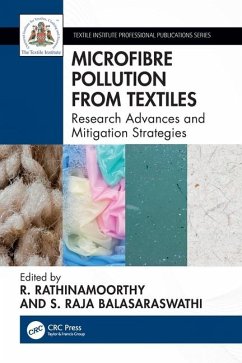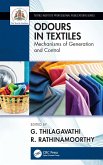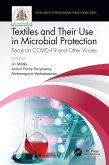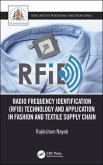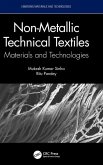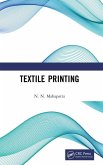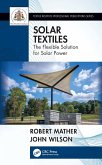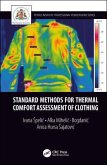Microfibre Pollution from Textiles
Research Advances and Mitigation Strategies
Herausgeber: Rathinamoorthy, R.; Balasaraswathi, S Raja
Microfibre Pollution from Textiles
Research Advances and Mitigation Strategies
Herausgeber: Rathinamoorthy, R.; Balasaraswathi, S Raja
- Broschiertes Buch
- Merkliste
- Auf die Merkliste
- Bewerten Bewerten
- Teilen
- Produkt teilen
- Produkterinnerung
- Produkterinnerung
Textile materials shed microfibres during different phases of their life cycle. While much attention has been paid to the impact of microplastics on the environment, there has been less focus on the impact of microfibre pollution, which also poses a serious environmental threat.
Andere Kunden interessierten sich auch für
![Odour in Textiles Odour in Textiles]() Odour in Textiles119,99 €
Odour in Textiles119,99 €![Textiles and Their Use in Microbial Protection Textiles and Their Use in Microbial Protection]() Textiles and Their Use in Microbial Protection117,99 €
Textiles and Their Use in Microbial Protection117,99 €![Radio Frequency Identification (Rfid) Technology and Application in Fashion and Textile Supply Chain Radio Frequency Identification (Rfid) Technology and Application in Fashion and Textile Supply Chain]() Rajkishore Nayak (Vietnam RMIT University)Radio Frequency Identification (Rfid) Technology and Application in Fashion and Textile Supply Chain198,99 €
Rajkishore Nayak (Vietnam RMIT University)Radio Frequency Identification (Rfid) Technology and Application in Fashion and Textile Supply Chain198,99 €![Non-Metallic Technical Textiles Non-Metallic Technical Textiles]() Mukesh Kumar SinhaNon-Metallic Technical Textiles137,99 €
Mukesh Kumar SinhaNon-Metallic Technical Textiles137,99 €![Textile Printing Textile Printing]() N. N. MahapatraTextile Printing98,99 €
N. N. MahapatraTextile Printing98,99 €![Solar Textiles Solar Textiles]() Robert MatherSolar Textiles106,99 €
Robert MatherSolar Textiles106,99 €![Standard Methods for Thermal Comfort Assessment of Clothing Standard Methods for Thermal Comfort Assessment of Clothing]() Ivana Spelic (University of Zagreb Faculty of Textile Technology)Standard Methods for Thermal Comfort Assessment of Clothing305,99 €
Ivana Spelic (University of Zagreb Faculty of Textile Technology)Standard Methods for Thermal Comfort Assessment of Clothing305,99 €-
-
-
Textile materials shed microfibres during different phases of their life cycle. While much attention has been paid to the impact of microplastics on the environment, there has been less focus on the impact of microfibre pollution, which also poses a serious environmental threat.
Hinweis: Dieser Artikel kann nur an eine deutsche Lieferadresse ausgeliefert werden.
Hinweis: Dieser Artikel kann nur an eine deutsche Lieferadresse ausgeliefert werden.
Produktdetails
- Produktdetails
- Textile Institute Professional Publications
- Verlag: Taylor & Francis Ltd
- Seitenzahl: 456
- Erscheinungstermin: 30. April 2024
- Englisch
- Abmessung: 234mm x 156mm x 24mm
- Gewicht: 724g
- ISBN-13: 9781032364452
- ISBN-10: 1032364459
- Artikelnr.: 70006105
- Herstellerkennzeichnung
- Libri GmbH
- Europaallee 1
- 36244 Bad Hersfeld
- gpsr@libri.de
- Textile Institute Professional Publications
- Verlag: Taylor & Francis Ltd
- Seitenzahl: 456
- Erscheinungstermin: 30. April 2024
- Englisch
- Abmessung: 234mm x 156mm x 24mm
- Gewicht: 724g
- ISBN-13: 9781032364452
- ISBN-10: 1032364459
- Artikelnr.: 70006105
- Herstellerkennzeichnung
- Libri GmbH
- Europaallee 1
- 36244 Bad Hersfeld
- gpsr@libri.de
R. Rathinamoorthy is Associate Professor in the Department of Fashion Technology, PSG College of Technology, Coimbatore, India. He is one of the world's top 2% scientists as reported by Elsevier and Stanford University. His areas of research are biomaterials for textiles and environmental pollution control due to textiles. S. Raja Balasaraswathi has a Master's degree in Fashion Technology from the National Institute of Fashion Technology, Bengaluru, India. She has conducted extensive research on microfiber pollution since 2019. She has published 17 research papers in international journals, has contributed 3 book chapters, and co-authored a book in the field of microfiber pollution.
Section One - Microfiber Pollution in the Textile and Fashion Industry.
1.An Introduction to Microfiber Pollution. 2.Impact of artificial ageing on
microfiber release from polyester textiles. 3.Factors influencing
microfiber emission from textiles and methods for quantifying microfiber
release during laundry processes. 4.Characterization and identification of
microfiber particles released in the washing process. 5.Microfibres from
Textile Industry Effluents. 6.Microfiber Contribution from Drying Clothes
is Critical in Estimating Total Microfiber Emissions from Textiles.
7.Microfibers pollution associated with disposable PPE products driven by
the COVID-19 pandemic and its environmental repercussions. Section Two -
Sources of Microfiber Pollution and Analytical Tools. 8.Quantifying
microfibre release from textiles during domestic laundering: Challenges and
progress. 9.Forensic Textile and Fibre Examinations for the Purposes of
Improved Recovery, Analysis and Interpretation of Microplastic Pollution.
10.Dynamic image analysis for determination of textile fibers. Section
Three - Impact of Microfiber Pollution. 11.The occurrence of natural and
synthetic fibers in the marine environment. 12.Dynamics of microfibers
discharged into the urban and suburban environment. 13.Indoor Microplastics
and Microfibers: Sources and Impacts on Human Health. 14.Microfiber
Pollution: Pathways to Health Impact. Section Four - Potential Mitigation
Strategies and Awareness. 15.Cross-disciplinary Collaboration Challenging
Microfibre Fragmentation in the Fashion and Textile Industries.
16.Mitigation strategies for microfiber pollution. 17.Together We Go
Further and Faster: A Review of Existing Policy Plans for Microfibre
Pollution. 18.Sustainable Approaches in textile finishing to control
microfiber releases. 19.Microfiber from Textiles - The new task of
standardization. 20.Aligning the textile industry towards the mitigation of
microfibre pollution.
1.An Introduction to Microfiber Pollution. 2.Impact of artificial ageing on
microfiber release from polyester textiles. 3.Factors influencing
microfiber emission from textiles and methods for quantifying microfiber
release during laundry processes. 4.Characterization and identification of
microfiber particles released in the washing process. 5.Microfibres from
Textile Industry Effluents. 6.Microfiber Contribution from Drying Clothes
is Critical in Estimating Total Microfiber Emissions from Textiles.
7.Microfibers pollution associated with disposable PPE products driven by
the COVID-19 pandemic and its environmental repercussions. Section Two -
Sources of Microfiber Pollution and Analytical Tools. 8.Quantifying
microfibre release from textiles during domestic laundering: Challenges and
progress. 9.Forensic Textile and Fibre Examinations for the Purposes of
Improved Recovery, Analysis and Interpretation of Microplastic Pollution.
10.Dynamic image analysis for determination of textile fibers. Section
Three - Impact of Microfiber Pollution. 11.The occurrence of natural and
synthetic fibers in the marine environment. 12.Dynamics of microfibers
discharged into the urban and suburban environment. 13.Indoor Microplastics
and Microfibers: Sources and Impacts on Human Health. 14.Microfiber
Pollution: Pathways to Health Impact. Section Four - Potential Mitigation
Strategies and Awareness. 15.Cross-disciplinary Collaboration Challenging
Microfibre Fragmentation in the Fashion and Textile Industries.
16.Mitigation strategies for microfiber pollution. 17.Together We Go
Further and Faster: A Review of Existing Policy Plans for Microfibre
Pollution. 18.Sustainable Approaches in textile finishing to control
microfiber releases. 19.Microfiber from Textiles - The new task of
standardization. 20.Aligning the textile industry towards the mitigation of
microfibre pollution.
Section One - Microfiber Pollution in the Textile and Fashion Industry.
1.An Introduction to Microfiber Pollution. 2.Impact of artificial ageing on
microfiber release from polyester textiles. 3.Factors influencing
microfiber emission from textiles and methods for quantifying microfiber
release during laundry processes. 4.Characterization and identification of
microfiber particles released in the washing process. 5.Microfibres from
Textile Industry Effluents. 6.Microfiber Contribution from Drying Clothes
is Critical in Estimating Total Microfiber Emissions from Textiles.
7.Microfibers pollution associated with disposable PPE products driven by
the COVID-19 pandemic and its environmental repercussions. Section Two -
Sources of Microfiber Pollution and Analytical Tools. 8.Quantifying
microfibre release from textiles during domestic laundering: Challenges and
progress. 9.Forensic Textile and Fibre Examinations for the Purposes of
Improved Recovery, Analysis and Interpretation of Microplastic Pollution.
10.Dynamic image analysis for determination of textile fibers. Section
Three - Impact of Microfiber Pollution. 11.The occurrence of natural and
synthetic fibers in the marine environment. 12.Dynamics of microfibers
discharged into the urban and suburban environment. 13.Indoor Microplastics
and Microfibers: Sources and Impacts on Human Health. 14.Microfiber
Pollution: Pathways to Health Impact. Section Four - Potential Mitigation
Strategies and Awareness. 15.Cross-disciplinary Collaboration Challenging
Microfibre Fragmentation in the Fashion and Textile Industries.
16.Mitigation strategies for microfiber pollution. 17.Together We Go
Further and Faster: A Review of Existing Policy Plans for Microfibre
Pollution. 18.Sustainable Approaches in textile finishing to control
microfiber releases. 19.Microfiber from Textiles - The new task of
standardization. 20.Aligning the textile industry towards the mitigation of
microfibre pollution.
1.An Introduction to Microfiber Pollution. 2.Impact of artificial ageing on
microfiber release from polyester textiles. 3.Factors influencing
microfiber emission from textiles and methods for quantifying microfiber
release during laundry processes. 4.Characterization and identification of
microfiber particles released in the washing process. 5.Microfibres from
Textile Industry Effluents. 6.Microfiber Contribution from Drying Clothes
is Critical in Estimating Total Microfiber Emissions from Textiles.
7.Microfibers pollution associated with disposable PPE products driven by
the COVID-19 pandemic and its environmental repercussions. Section Two -
Sources of Microfiber Pollution and Analytical Tools. 8.Quantifying
microfibre release from textiles during domestic laundering: Challenges and
progress. 9.Forensic Textile and Fibre Examinations for the Purposes of
Improved Recovery, Analysis and Interpretation of Microplastic Pollution.
10.Dynamic image analysis for determination of textile fibers. Section
Three - Impact of Microfiber Pollution. 11.The occurrence of natural and
synthetic fibers in the marine environment. 12.Dynamics of microfibers
discharged into the urban and suburban environment. 13.Indoor Microplastics
and Microfibers: Sources and Impacts on Human Health. 14.Microfiber
Pollution: Pathways to Health Impact. Section Four - Potential Mitigation
Strategies and Awareness. 15.Cross-disciplinary Collaboration Challenging
Microfibre Fragmentation in the Fashion and Textile Industries.
16.Mitigation strategies for microfiber pollution. 17.Together We Go
Further and Faster: A Review of Existing Policy Plans for Microfibre
Pollution. 18.Sustainable Approaches in textile finishing to control
microfiber releases. 19.Microfiber from Textiles - The new task of
standardization. 20.Aligning the textile industry towards the mitigation of
microfibre pollution.

